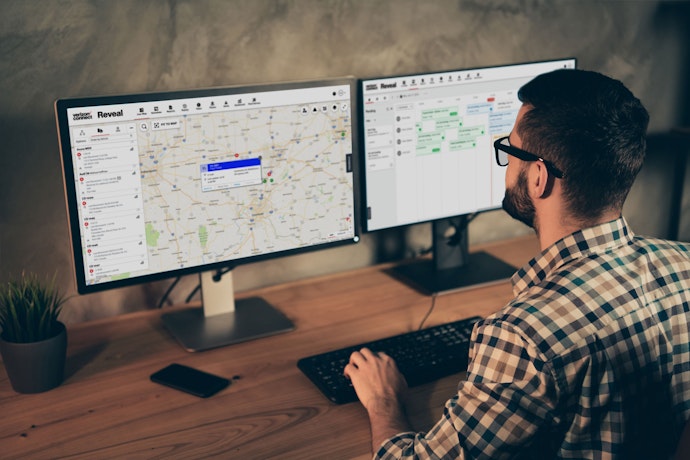9 Secrets to Reducing your Fleet Expenses
As a fleet owner, your day-to-day costs can quickly add up. What you don’t know is there are further hidden, expensive...
Read more
Improving safety, productivity and energy efficiency within fleet management has become a priority in order to maintain the competitiveness of companies. The boom in the use of In-Vehicle Monitoring Systems (IVMS) is unstoppable. In the UK, more and more vehicle fleets are implementing these intelligent mobility solutions to improve performance, efficiency and safety.
We are experiencing a real (r)evolution of fleet management marked by a digital transformation that is far from the beginnings of GPS location systems. The evolution of these systems goes far beyond vehicle locations on a map.
The digital transformation of fleet management has a direct impact on crucial strategic areas such as customer service, innovation, energy efficiency and cost reduction. This helps companies to stay one step ahead of the competition.
The potential of vehicle tracking systems is to provide a global fleet tracking management platform that helps you drive your business forward. With a 360° view of your equipment and vehicles on a live map, you’re constantly receiving insights to help you improve performance and your bottom line.
Companies that have already implemented Vehicle Monitoring Systems (IVMS) have achieved reduced fuel consumption, better productivity, a reduced number of violations and improved profitability.
IVMS units are usually installed in a vehicle’s OBDII port and track both GPS vehicle location as well as data from the engine control units such as fuel consumption data, engine idle time, Diagnostic Trouble Codes (DTCs) and sudden changes in speed.
The GPS tracking device transmits real-time data back to a centralised server over mobile phone networks to allow fine-grained access control for fleet managers via user-friendly client software.
Let's dive a little bit more into the potential of Vehicle Monitoring Systems for your fleet operations and your whole business:
Monitor the activity of your teams remotely. With an In-Vehicle Monitoring System, you will be able to see vehicle and driver location on a live map and act quickly in case of any issues or accidents. You should be able to send help quickly and better protect your equipment and vehicles on the go.
Identify the behaviour of your drivers behind the wheel. All those bad practices that put at risk the safety of your equipment and vehicles. We are talking about harsh acceleration, sudden braking, excessively fast cornering, not wearing a seat belt and other poor driving styles.
Although the UK’s road safety record is generally very good, with an estimated 28 fatalities per million inhabitants in 2018, it’s still vital to address such safety concerns in order to further improve driver behaviour. This importance is underlined by the fact that there were 0.88 fatal accidents at work per 100,000 employees in 2017.
Vehicle Monitoring Systems can help us to encourage efficient driving between our equipment and vehicles that is characterised by promoting low fuel consumption, a reduction in environmental pollution, greater driving comfort and a reduction in risk on the road.
Have full view of your fleet's performance in one easy, digestible dashboard. Important insights like job progress, vehicle activity, idling, distance travelled and fuel costs help to analyse daily operations and improve your performance in the field as well as reducing the fleet's operations costs.
Big Data has led to a transformation of fleets and companies. Thanks to telematics, this valuable data will be used to help identify potential areas for improvement in your business, uncover hidden costs resulting from bad driving behaviour and detect engine errors before they cause a big breakdown.
Reducing your fleet's costs should be a priority in order to help improve your bottom line. A GPS tracking solution may work to reduce your fleet's expenses but also to progress your fleet's day-to-day performance.
View job progress and your team's performance in the field. With better fleet visibility, you can take stock of what you have and how your resources have been used. Then you can assess whether they could be used more efficiently to get more things done with fewer resources.
This will help to reduce inactive periods and align customer needs with your business resources, vehicles and team to help boost productivity.
Telematics is a great ally to help boost your fleet's processes with ease. Supervise all the daily operations and have all your team and vehicles under control. Fleet managers have to protect their team and vehicles and the good news is, vehicle tracking devices like In-Vehicle Monitoring Systems (IVMS) are on our side.
Find out how our platform gives you the visibility you need to get more done: Request a demo today.
Tags: All



Find out how our platform gives you the visibility you need to get more done.
As a fleet owner, your day-to-day costs can quickly add up. What you don’t know is there are further hidden, expensive...
Read moreVerizon Connect Reveal tracks the fleet data that can have a big impact on your business. These are things like where...
Read moreAt Verizon Connect, we can only provide the highest possible level of service to fleet managers and business owners by...
Read moreReveal tracks the fleet data that can have a big impact on your business. These are things like where your vehicles are...
Read more